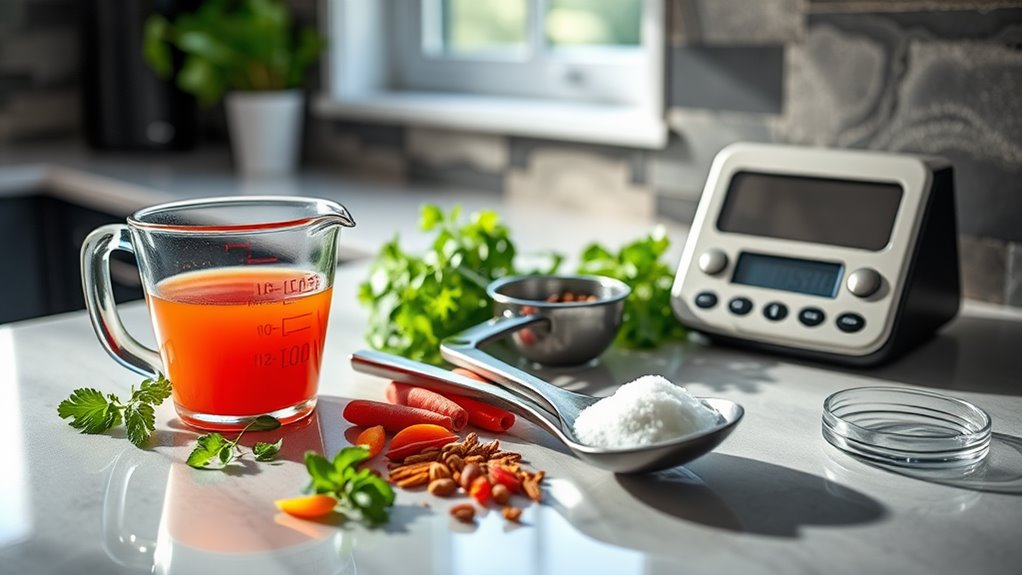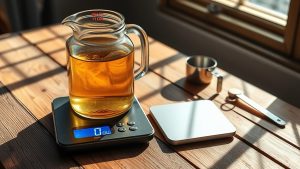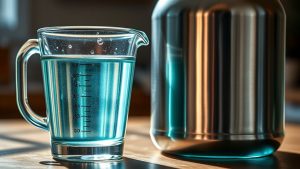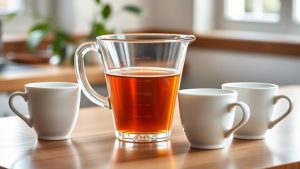
In cooking, it's essential to know how many ounces are in common conversions. One cup equals eight fluid ounces, while two cups make sixteen ounces. A pint also contains sixteen ounces, and a quart has thirty-two ounces. If you're dealing with larger quantities, a gallon equals 128 ounces. For smaller measurements, two tablespoons or six teaspoons equal one fluid ounce. Understanding these basics helps you achieve precise measurements, leading to successful recipes and ideal flavors. There's more to explore on this topic.
When measuring liquid ingredients in the kitchen, it's essential to understand the relationship between ounces and other common volume units. Knowing how to convert between these units can greatly enhance your cooking and baking precision. For instance, one cup equals eight fluid ounces. This fundamental conversion forms the basis for many recipes. If you need to measure two cups, simply multiply eight by two, resulting in sixteen fluid ounces.
Understanding pints, quarts, and gallons also plays an important role in your kitchen measurements. A pint contains sixteen fluid ounces, which means that two pints equal one quart, and a quart consists of thirty-two fluid ounces. If you're scaling up a recipe, knowing that four quarts make up one gallon, with a total of 128 fluid ounces, can help you determine the right quantities without hassle.
Understanding fluid measurements like pints, quarts, and gallons streamlines your cooking and helps you scale recipes effortlessly.
When it comes to metric conversions, you can further broaden your understanding of fluid ounces. If you ever need to convert fluid ounces to milliliters, multiply the number of fluid ounces by 30. For example, if a recipe calls for eight fluid ounces, that would equal approximately 240 milliliters. This handy conversion is particularly useful if you're following recipes from different countries or using metric measuring tools.
Furthermore, when dealing with smaller measurements, you might need to convert tablespoons and teaspoons into fluid ounces. Remember that two tablespoons equal one fluid ounce and that six teaspoons equal one fluid ounce as well. This knowledge can be particularly handy when you're working with smaller quantities of ingredients like vanilla extract or lemon juice.
It's important to distinguish between liquid and dry measurements, as they aren't interchangeable. For instance, a cup of flour weighs differently than a cup of water. One cup of all-purpose flour typically weighs around 120 grams, which is approximately 4.25 ounces. If you're measuring dry ingredients, be mindful that the density of the ingredient can affect the conversion. Understanding fluid ounce conversions is essential for accurate baking.
If you're purchasing ingredients in bulk, understanding container sizes is equally important. A regular scoop usually holds one cup, while small plastic tubs can contain eight ounces, and large tubs can hold up to 32 ounces. By knowing how many fluid ounces are in each container size, you can better manage your stock and avoid running out of essential ingredients.
Lastly, when calculating costs, converting total amounts to pounds helps in determining the price per pound for bulk purchases. Since one gallon is roughly 3.8 liters, and one gallon equals 128 fluid ounces, you can efficiently compare prices based on volume and weight.
Conclusion
In conclusion, understanding how many ounces are in common conversions can simplify your cooking and baking tasks greatly. Isn't it comforting to know that a quick reference can save you from the frustration of mismeasuring? Whether you're converting cups, pints, or quarts, these conversions are essential for accuracy in the kitchen. By mastering these basics, you'll guarantee your culinary creations turn out just right every time, making your cooking experience both enjoyable and successful.



